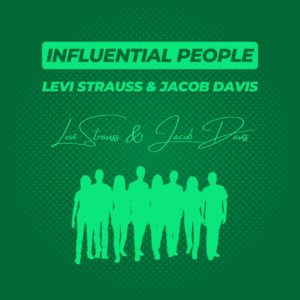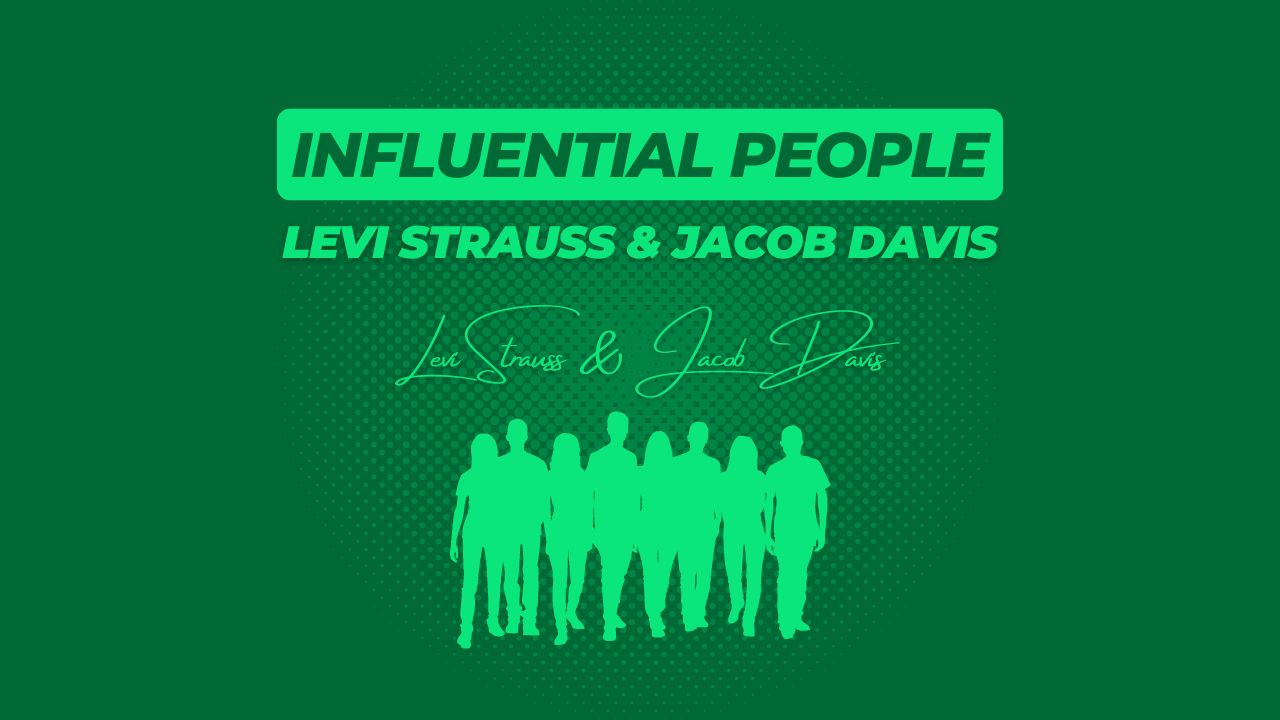When it comes to fashion icons, few have left as indelible a mark as Levi Strauss and Jacob Davis. Their pioneering invention, the blue jean, originally designed as durable workwear for American labourers, has transcended its utilitarian origins to become a cornerstone of modern casual wear. The partnership between Strauss, a Bavarian immigrant turned San Francisco businessman, and Davis, a tailor from Reno, Nevada, led to the birth of an apparel revolution with the patenting of riveted denim jeans in 1873. This innovation not only transformed the landscape of fashion but also became a cultural symbol, influencing countless social and youth movements across generations.
Francisco businessman, and Davis, a tailor from Reno, Nevada, led to the birth of an apparel revolution with the patenting of riveted denim jeans in 1873. This innovation not only transformed the landscape of fashion but also became a cultural symbol, influencing countless social and youth movements across generations.
The ubiquity of jeans in today’s fashion repertoire speaks volumes about their versatility and universal appeal, traits that make them a staple in social settings, from casual outings to more laid-back office environments. In the realm of dating, the simple denim jean has played a subtle yet significant role. As a garment that crosses boundaries of class, age, and style, jeans foster a sense of comfort and authenticity, qualities highly prized in modern dating scenarios. Their ability to blend into various social situations while maintaining a sense of individuality mirrors the dynamics of contemporary relationships, where adaptability and authenticity often dictate social interactions and connections. This article delves into how Levi Strauss and Jacob Davis not only stitched together fabric but also sewed the seeds of a cultural legacy that continues to influence our social fabric today.
Early Life and Background
Levi Strauss
Levi Strauss was born in 1829 in Buttenheim, Bavaria, to a family of Jewish dry goods sellers. In pursuit of greater opportunities, Strauss emigrated to the United States in 1847, amidst the waves of the European revolutions that propelled many to seek new lives in America. Settling initially in New York where his brothers ran a goods store, Strauss quickly adapted to the bustling American commerce scene. In 1853, sensing the untapped potential of the booming West during the Gold Rush, Strauss moved to San Francisco. He established a wholesale dry goods business under his name, Levi Strauss & Co., which catered to the general needs of the small but rapidly growing communities in the West.
Jacob Davis
Jacob Davis, born Jacob Youphes in Riga, Latvia in 1831, also journeyed to America, arriving slightly later than Strauss. Davis tried his hand at various trades across the United States and Canada before settling as a tailor in Reno, Nevada. His craft involved fabricating sturdy items such as tents, horse blankets, and wagon covers from heavy-duty canvas he obtained from Levi Strauss & Co. The turning point in Davis’s career, however, came with his innovative idea to use copper rivets to reinforce the points of strain on the pants he made for labourers, enhancing their durability.
The paths of Strauss and Davis converged when Davis, recognising the potential of his riveting method but lacking the funds to patent the idea, wrote to Strauss in 1872. He proposed that they go into business together. Intrigued by the practicality and commercial potential of Davis’s innovation, Strauss agreed, and the two men secured a patent in 1873 for “Improvement in Fastening Pocket-Openings,” marking the beginning of a partnership that would radically reshape the world of apparel.
The Birth of an Icon
The initial collaboration between Levi Strauss and Jacob Davis was marked by a shared vision to create something durable and practical for the hardworking people of America’s burgeoning frontier towns. The genesis of this partnership was Davis’s simple yet ingenious idea: to reinforce the points of strain on work trousers with copper rivets. This concept was born out of necessity when a customer, a labourer, complained about the rapid wear and tear of his trousers. Davis’s solution was not just effective but transformative. He placed rivets at the corners of pocket openings and at the base of the button fly, areas typically prone to the most stress and tear.
Realising the potential of his riveting idea but lacking the financial means to secure a patent, Davis turned to Strauss in 1872 with a proposition: if Strauss would handle the patenting and marketing, Davis would manage the manufacturing side of a joint venture. Strauss, seeing the practical and commercial potential, readily agreed. In 1873, Strauss and Davis received U.S. Patent No. 139,121 for an “Improvement in Fastening Pocket-Openings.” This patent officially made them the inventors of what we now know as blue jeans.
This innovation was revolutionary in the textile and fashion industry. Initially, these “waist overalls,” as they were then known, were crafted from a heavy blue denim fabric sourced by Strauss, which was more suitable than the original canvas. The introduction of indigo blue dye made the pants more appealing while hiding dirt and wear, which was ideal for miners, cowboys, and railroad workers—the primary consumers of these garments.
The riveted trousers quickly became a staple in the wardrobes of America’s working class. Their popularity grew as tales of their durability and practicality spread across the United States, turning Levi Strauss & Co. into a household name and setting the stage for jeans to become one of the most iconic garments in the world.
Impact on Fashion
The invention of riveted jeans by Levi Strauss and Jacob Davis marked a significant shift in the landscape of workwear, setting the stage for a cultural revolution that would permeate societies worldwide. Originally designed as robust clothing for labor-intensive jobs, jeans soon transcended their utilitarian origins to become a symbol of fashion and identity.
From Workwear to Wardrobe Essential
In the early 20th century, jeans were primarily worn by miners, farmers, and ranchers due to their durability and comfort. However, the narrative began to shift during the 1930s and 1940s, when jeans became popular among young people, particularly within the emerging cowboy movies and the rodeo circuit. Hollywood films depicting rugged, denim-clad heroes contributed significantly to jeans’ appeal, embedding them in the aspirational American lifestyle.
Cultural Revolution and Mainstream Acceptance
The real transformation of jeans into a fashion staple came in the 1950s and 1960s, when they became associated with rebellion and youth culture. Icons like James Dean and Marlon Brando wore jeans in films that challenged societal norms, positioning denim as a symbol of defiance against the status quo. This association resonated deeply with the youth, propelling jeans to the forefront of popular culture.
As jeans continued to be identified with various subcultures, including rockers, hippies, and later punk movements, they began to signify more than just casual attire—they represented a social statement against conformity. By the 1970s and 1980s, designers and high-fashion houses began to take notice, incorporating jeans into their collections, thus elevating their status from everyday wear to high fashion items. This period saw the birth of designer jeans, with brands like Calvin Klein and Guess featuring jeans prominently in their lines and advertising campaigns.
Modern Era and Global Appeal
Today, jeans are universally worn across different age groups, ethnicities, and social classes. They have been continually reimagined through various cuts, colors, and finishes, adapting to changing fashion trends while maintaining their core identity as durable, comfortable, and stylish. The adaptability of jeans allows them to remain relevant in the fashion industry, influencing styles across generations and continuously reinventing their significance in culture and society.
The impact of Strauss and Davis’s invention on fashion is profound, illustrating how a simple design intended for functionality can evolve into a global fashion phenomenon, influencing not just what people wear but how they express their identities and align with broader cultural movements.
Cultural and Social Influence
Jeans have played a pivotal role in shaping cultural and social norms, evolving from practical workwear to powerful symbols of rebellion, youth culture, and freedom. This transformation is rooted in specific historical contexts where jeans have featured prominently.
Symbol of Rebellion and Youth Culture
In the 1950s, jeans became emblematic of the teenage rebellion against the conservative norms of the time. Cultural icons like James Dean in Rebel Without a Cause and Marlon Brando in The Wild One donned jeans as part of their anti-hero personas, embodying a spirit of defiance that resonated deeply with the youth. This connection between denim and dissent was not merely about fashion but reflected a broader discontent with societal expectations and a yearning for personal expression.
The 1960s and 1970s saw the counterculture movement adopt jeans as a uniform of non-conformity, further entrenching their status as emblems of rebellion. During this period, jeans were a common sight at anti-war demonstrations, civil rights marches, and the burgeoning feminist movement, symbolising solidarity and resistance across various social causes. The versatility and ruggedness of jeans made them ideal for these activists who required durable clothing that could withstand the rigors of prolonged protests and sit-ins.
Jeans in the Modern Dating Scene
In contemporary society, jeans remain a staple in casual wear and have taken on a role as a social equaliser in the dating scene. Their ubiquity across different demographics makes them accessible and relatable, allowing individuals to express themselves while adhering to a universally accepted dress code. In the context of modern dating, jeans help demystify and level the social playing field, reducing the emphasis on economic status or social class. This is particularly evident in online dating profiles and casual first-date scenarios, where choosing to wear jeans can signal approachability and comfort, qualities that are prized in potential partners.
Furthermore, the evolution of jeans into various styles—skinny, bootcut, straight, or distressed—allows for personal expression within the framework of a common garment. This versatility makes jeans an ideal choice for dates and social interactions, as they can be styled up or down depending on the occasion, reflecting individual personality while still fitting within broader social norms.
The cultural and social impact of jeans underscores their significance not just as a fashion item but as a cultural artefact that reflects and influences societal trends and individual identities. In the realm of dating and social interactions, jeans continue to serve as both a canvas for personal expression and a bridge that connects diverse social elements, embodying a unique blend of comfort, style, and equality.
Legacy and Continuing Influence
The legacy of Levi Strauss and Jacob Davis is not just sewn into the fabric of their jeans but woven into the very fabric of global culture. Their pioneering spirit and innovative design have left an indelible mark on fashion and society, with the Levi’s brand epitomising this enduring influence.
Global Expansion of Levi’s Brand
Since its inception, Levi’s has grown from a regional manufacturer of workwear into a global icon, synonymous with quality, rebellion, and Americana. The expansion of Levi’s brand worldwide has been phenomenal, with its products being sold in more than 110 countries today. This global reach underscores the universal appeal of jeans, transcending cultural and geographic boundaries. Levi’s has adeptly transformed itself through various fashion cycles, continuously appealing to new generations while retaining loyal customers through its heritage lines. The brand’s ability to innovate while staying true to its roots is a key component of its lasting appeal.
Enduring Appeal and Influence on Fashion and Social Norms
The innovation of Strauss and Davis—the introduction of rivets in pants—remains a fundamental aspect of jeans construction, reflecting the enduring nature of their initial invention. This innovation has not only persisted but has also evolved, influencing fashion and social norms across the world. Jeans today are more than just clothing; they are a statement of identity and a staple of various fashion movements. From high-fashion runways to street style, from the boardrooms to skate parks, jeans maintain their status as the ultimate democratiser of fashion.
The cultural relevance of jeans continues to be as significant today as it was in the past. They are often at the forefront of conversations about sustainability in fashion, with the denim industry seeking ways to reduce its environmental impact through better practices and innovative technologies. This focus on sustainability is a testament to the evolving nature of jeans, adapting to contemporary concerns while maintaining their cultural and stylistic significance.
Reflection on Social Influence
Strauss and Davis’s creation has also continued to influence social norms, challenging traditional dress codes and promoting a more relaxed and inclusive approach to professional and personal attire. In many ways, jeans have helped blur the lines between different social classes, ages, and genders, promoting a more egalitarian approach to how people dress and interact. Their versatility and acceptance in various social settings continue to make them a powerful tool for personal expression and social interaction.
The legacy of Levi Strauss and Jacob Davis is thus not confined to the past; it is a living, evolving influence that continues to shape fashion and societal norms around the world. Their contribution to the world of fashion is a reminder of how a simple yet innovative idea can have a profound and lasting impact on global culture.
Conclusion
The story of Levi Strauss and Jacob Davis is more than a chapter in the history of fashion; it’s a narrative that has woven itself into the fabric of society. The humble beginnings of their partnership and the revolutionary introduction of riveted jeans have spurred a cultural shift that extends far beyond the boundaries of fashion. Their legacy is seen not just in the enduring popularity of jeans but in their profound impact on societal norms and individual expressions.
Jeans, once a utilitarian garment designed for the rugged needs of the American worker, have transcended their original purpose to become a ubiquitous symbol of style, rebellion, and freedom. They have broken down barriers across social strata, offering a common thread that links the wealthy and the working-class, the old and the young, and all genders alike. In fashion, jeans have proven remarkably versatile, continuously reinvented by each generation to suit its ethos and aesthetic, yet always retaining that original spirit of durability and practicality.
In societal interactions, particularly in the modern context of dating and personal relationships, jeans embody the democratic nature of contemporary fashion. They allow individuals to express nuances of their personality and cultural identity in a world that increasingly values authenticity and personal connection over formality and pretension.
Reflecting on the transformative journey of jeans invites us to consider broader questions about the role of clothing in shaping our personal and social identities:
How do our sartorial choices reflect our values and aspirations, and in what ways do they influence how we relate to others, particularly in the intimate spheres of dating and personal relationships?
This question encourages us to think about fashion not just as a means of self-expression but as a powerful mediator of human connections and cultural dialogues.






